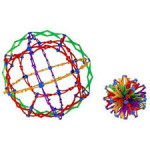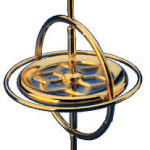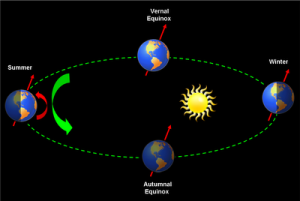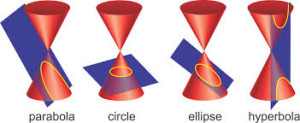 This weekend we focused on using energy lines in new ways. So far, we have been using lines and circles/spheres of energy to create simultaneous balance and extension (moving out of tension) in the postures. The Hoberman Sphere has been our metaphor for breathing as expanding and condensing, and sustaining an internal, 3-dimensional spaciousness. The circle is the feminine side of sacred geometry, and to this we have added the masculine, the
This weekend we focused on using energy lines in new ways. So far, we have been using lines and circles/spheres of energy to create simultaneous balance and extension (moving out of tension) in the postures. The Hoberman Sphere has been our metaphor for breathing as expanding and condensing, and sustaining an internal, 3-dimensional spaciousness. The circle is the feminine side of sacred geometry, and to this we have added the masculine, the  straight line, as an axis through the sphere to give is another polarity, such as head and tail, or heaven and earth. From these we have created the basic shape of an organism centered in the cosmos. The gyroscope gives us the sense of dynamic stability the is at the essence of all life.
straight line, as an axis through the sphere to give is another polarity, such as head and tail, or heaven and earth. From these we have created the basic shape of an organism centered in the cosmos. The gyroscope gives us the sense of dynamic stability the is at the essence of all life.
For the next level, we will begin to explore some new energy shapes based on what are known in math as the conic  sections. These are defined by the different angles one can slice through a cone. We have played with the circle so the next to come is the ellipse. Like the circle, the ellipse is a closed shape, but where as the circle has a single center to define its perimeter, the ellipse has two centers, known as focal points. We use the elliptical
sections. These are defined by the different angles one can slice through a cone. We have played with the circle so the next to come is the ellipse. Like the circle, the ellipse is a closed shape, but where as the circle has a single center to define its perimeter, the ellipse has two centers, known as focal points. We use the elliptical  shape to explore 2 chakras at a time , one at each focal point. For example, when lying in savasana, or any supported position, we can imagine the heart chakra at one focus and the navel center, or the sacral center as the second. Any two chakras will work, but if you use the alternating ones, (1-3, 2-4, 3-5, etc) the chkra between can also emerge as the center of the two focal points.
shape to explore 2 chakras at a time , one at each focal point. For example, when lying in savasana, or any supported position, we can imagine the heart chakra at one focus and the navel center, or the sacral center as the second. Any two chakras will work, but if you use the alternating ones, (1-3, 2-4, 3-5, etc) the chkra between can also emerge as the center of the two focal points.  The earth’s path around the sun, as well as that of the other planets, is ellipsoidal, so this is a very cosmic, macro-phase pattern to align with.
The earth’s path around the sun, as well as that of the other planets, is ellipsoidal, so this is a very cosmic, macro-phase pattern to align with.
When we come to the parabolic and hyperbolic curves, we enter a new phase in our integration as these are open curves, coming from outside the body, passing through us, and then moving on again. From the conic perspective, the parabolic curve is  parallel to the edge of the cone, where as the hyperbola is parallel to the perpendicular axis of the cone. Hyperbolas also come in pairs, but one half is enough for our somatic play. Parabolic curves are more focused, and such are used in mirrors and auto headlights. Hyperbolas are more open, that is the ‘arms’ can spread wider.
parallel to the edge of the cone, where as the hyperbola is parallel to the perpendicular axis of the cone. Hyperbolas also come in pairs, but one half is enough for our somatic play. Parabolic curves are more focused, and such are used in mirrors and auto headlights. Hyperbolas are more open, that is the ‘arms’ can spread wider.
Try standing in a nice simple, grounded tadasana, find your heart center, and from there open the arms, pointing slight up and forward. If you have some anatomical sensitivity, align the shoulder girdles, arm bones, ribs and heart center into a parabolic shape and let the bones, muscles, connective tissues, blood vessels etc feel suspended and supported by the energy flowing through you. Widen to find some hyperbolic lines.
This can also be done lying down, with arms up and out to ceiling, or even with the legs, like a parabolic or hyperbolic anemone. In any pose, invite these in to light up aspects of your interior, or to bring into focus cells, organs or any structure that invites you.
Homework for the final sessions: Review, Read Hsin Hsin Ming, continue with Gita and Sutras as you feel inspired. Keep practicing.

